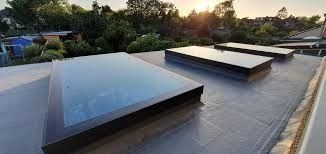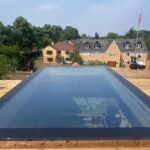Natural light is a key element in modern architecture, and skylights are one of the most effective ways to bring that light into your home or office. If you have a flat roof, one of the most stylish and functional options available is the flat roof glass skylight. Combining sleek design with practicality, these skylights are ideal for contemporary buildings looking to enhance indoor light, energy efficiency, and aesthetics.
In this guide, we’ll cover everything you need to know about flat roof glass skylights—what they are, their benefits, design options, installation considerations, and how to maintain them.
What Are Flat Roof Glass Skylights?
A flat roof glass skylight is a fixed or opening window unit installed on flat or low-pitch roofs. Unlike traditional domed skylights, these units are made of high-performance glass and offer a clear, unobstructed view of the sky. They are designed to sit either flush with the roof or slightly raised on a kerb (frame), depending on your design and drainage needs.
Available in various sizes and shapes, flat roof glass skylights can be tailored to suit almost any residential or commercial space.
Benefits of Flat Roof Glass Skylights
1. Abundant Natural Light
Glass skylights allow natural daylight to flood your interior spaces, making rooms feel bigger, brighter, and more welcoming. This reduces the need for artificial lighting during the day.
2. Energy Efficiency
High-quality double or triple-glazed units improve insulation, helping regulate indoor temperatures and reduce energy bills. Some models include solar-reflective coatings to limit heat gain in summer.
3. Modern Aesthetic
Flat roof glass skylights offer a clean, minimalist look that blends beautifully with modern architecture. The clear glass and slim frames create a high-end visual appeal both inside and out.
4. Improved Ventilation (Optional Models)
Some flat roof skylights come with opening mechanisms—manual or electric—allowing fresh air into the space and improving airflow.
5. Increased Property Value
Homes and offices with stylish natural lighting solutions often command higher market value and appeal.
Types of Flat Roof Glass Skylights
Fixed Skylights
These do not open and are ideal for areas where ventilation is not required. They’re perfect for maximizing light in living rooms, hallways, or offices.
Opening Skylights
These can be opened manually or via remote control. Great for kitchens and bathrooms where heat and humidity buildup needs to be controlled.
Walk-On Skylights
Designed to be strong enough for foot traffic, these are installed on roof terraces or balconies and add a unique architectural element.
Considerations Before Installation
Roof Compatibility
Flat roof glass skylights are compatible with various roof types—EPDM rubber, fiberglass, bitumen, and more. Always consult a roofing professional to ensure proper fit and installation.
Drainage and Upstand
Proper drainage is critical. Most skylights are installed with an upstand (kerb) that raises the unit above the roofline to prevent water pooling.
Glazing Options
Choose from double or triple glazing depending on insulation needs. You can also opt for:
- Solar control glass
- Tinted or frosted glass
- Laminated safety glass
Building Regulations
Depending on your location, you may need planning permission or must comply with building codes. A licensed installer can help ensure compliance.
Maintenance and Cleaning
Flat roof glass skylights are designed to be low maintenance. However, occasional care will extend their lifespan:
- Cleaning: Use mild soap and water to clean the glass. Many models have self-cleaning coatings to reduce grime buildup.
- Inspection: Check seals and flashing for wear and tear annually.
- Debris Removal: Clear leaves, snow, and dirt from around the frame to prevent water blockage.
Conclusion
A flat roof glass skylight is more than just a design feature—it’s a smart investment in your home’s comfort, energy efficiency, and value. Whether you’re building new, renovating, or upgrading an older property, these skylights offer a stylish and sustainable way to bring the beauty of natural light indoors.


